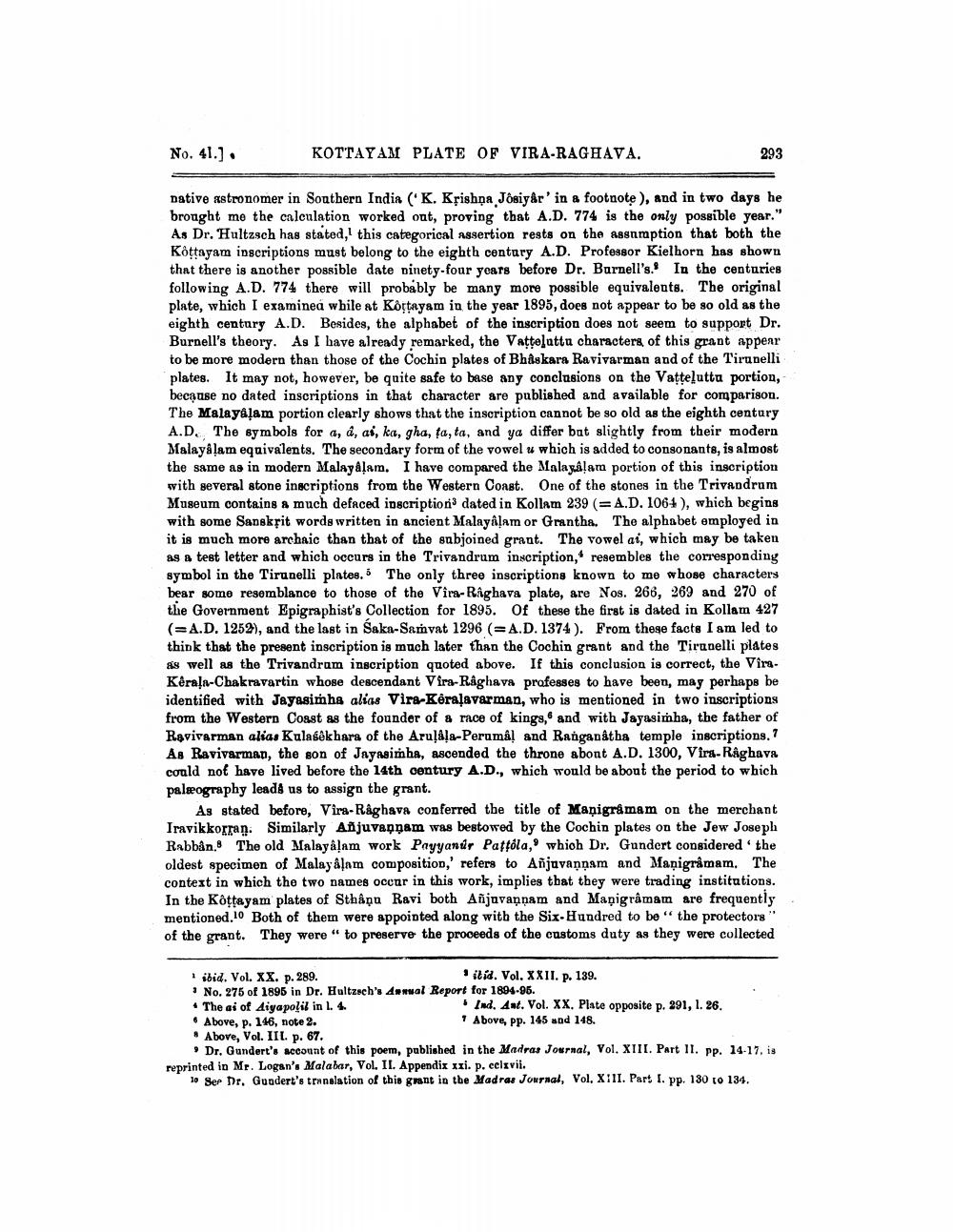________________
No. 41.).
KOTTAYAM PLATE OF VIRA-RAGHAVA.
293
native astronomer in Southern India ('K. Krishņa Josiyår' in a footnote), and in two days he brought me the calculation worked out, proving that A.D. 774 is the only possible year." As Dr. Hultzsch has stated, this categorical assertion rests on the assnmption that both the Kottayam inscriptions must belong to the eighth centary A.D. Professor Kielhorn has shown that there is another possible date ninety-four years before Dr. Barnell's. In the centuries following A.D. 774 there will probably be many more possible equivalents. The original plate, which I examined while at Kottayam in the year 1895, does not appear to be so old as the eighth century A.D. Besides, the alphabet of the inscription does not seem to support Dr. Burnell's theory. As I have already remarked, the Vattelatta characters, of this grant appear to be more modern than those of the Cochin plates of Bhaskara Ravivarman and of the Tirunelli plates. It may not, however, be quite safe to base any conclusions on the Vatteluttu portion, because no dated inscriptions in that character are published and available for comparison. The Malayalam portion clearly shows that the inscription cannot be so old as the eighth century A.D. The symbols for a, a, as, ka, gha, ta, ta, and ya differ bat slightly from their modern Malayalam equivalents. The secondary form of the vowel u which is added to consonants, is almost the same as in modern Malayalam. I have compared the Malayalam portion of this inscription with several stone inscriptions from the Western Coast. One of the stones in the Trivandrum Museum contains a much defaced inscription dated in Kollam 239 (= A.D. 106+), which begins with some Sansksit words written in ancient Malayalam or Grantha. The alphabet employed in it is much more archaic than that of the subjoined grant. The vowel ai, which may be taken as a test letter and which occurs in the Trivandrum inscription, resembles the corresponding symbol in the Tirunelli plates. The only three inscriptions known to me whose characters bear some resemblance to those of the Vira-Raghava plate, are Nos. 266, 269 and 270 of the Government Epigraphist's Collection for 1895. Of these the first is dated in Kollam 427 (=A.D. 1252), and the last in Saka-Samvat 1296 (=A.D. 1374). From these facts I am led to think that the present inscription is much later than the Cochin grant and the Tirunelli plates as well as the Trivandrum inscription quoted above. If this conclusion is correct, the ViraKéra!a-Chakravartin whose descendant Vira-Raghava professes to have been, may perhaps be identified with Jayasimha alias Vira-Kéraļavarman, who is mentioned in two inscriptions from the Western Coast as the founder of a race of kings, and with Jayasimha, the father of Ravivarman alias Kulasekhara of the Aru!Ala-Perumal and Ranganatha temple inscriptions. As Ravivarman, the son of Jayasimha, ascended the throne abont A.D. 1300, Vira-Raghava could not have lived before the 14th century A.D., which would be about the period to which palæography leads us to assign the grant.
As stated before, Vira-Raghava conferred the title of Manigramam on the merchant Iravikkorran. Similarly Aõjuvannam was bestowed by the Cochin plates on the Jew Joseph Rabbân. The old Malayalam work Payyanur Patfôla, which Dr. Gundert considered the oldest specimen of Malayalam composition,' refers to Añjuvannam and Manigramam. The context in which the two names occur in this work, implies that they were trading institutions. In the Kottayam plates of Sthåņu Ravi both Añjavannam and Maộigramam are frequently mentioned. 10 Both of them were appointed along with the Six-Hundred to be the protectors" of the grant. They were to preserve the proceeds of the customs duty as they were collected
* ibid. Vol. XX. p. 289.
itid. Vol. XXII. p. 139. No. 275 of 1895 in Dr. Hultzsch's Assual Report for 1894-95. * The as of Aiyapolil in l. 4.
• Ind. Ant. Vol. XX. Plate opposite p. 291, 1.26. • Above, p. 146, note 2.
1 Above, pp. 145 and 148. # Above, Vol. IIl. p. 67.
Dr. Gundert's account of this poem, published in the Madras Journal, Vol. XIII. Part II. pp. 14-17, is reprinted in Mr. Logan's Malabar, Vol. II. Appendix xii. p. cclxvii.
10 Sep Dr. Gundert's translation of this grant in the Madras Journal, Vol. X111. Part I. pp. 130 to 134.




